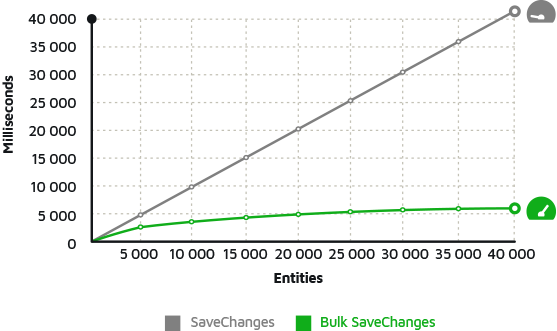Entity Framework Insert Discover How to Improve Insert Performance
How to Improve Entity Framework Insert Performance?
When you want to insert hundreds, thousands, or millions of entities, and your application suffers from performance issues.
using (var ctx = new CustomerContext()) { List<Customer> customers = new List<Customer>(); foreach(var line in lines) { var customer = new Customer(); // ...code... customers.Add(customer); } ctx.Customers.AddRange(customers); ctx.SaveChanges(); }
The DbContext.SaveChanges is a poor choice for BULK operations as far as performance is concerned. Once you get beyond a few thousand records, the SaveChanges method really starts to break down.
StackOverflow Related Questions
- Fastest Way of Inserting in Entity Framework
- Writing to large number of records takes too much time using Entity Framework
Answer
There are many solutions to insert many records into the database in an efficient way.
- Use BulkInsert (Recommended)
- Use SqlBulkCopy
BulkInsert
The most significant and recommended solution is BulkInsert provided by Entity Framework Extensions library.
Performance Comparisons
| Operations | 1,000 Entities | 2,000 Entities | 5,000 Entities |
|---|---|---|---|
| SaveChanges | 1,000 ms | 2,000 ms | 5,000 ms |
| BulkInsert | 6 ms | 10 ms | 15 ms |
Steps to use BulkInsert
- CREATE a list
- ADD entity to the list
- USE BulkInsert
- Done!
using (var ctx = new CustomerContext()) { // 1. CREATE a list List<Customer> customers = new List<Customer>(); foreach(var line in lines) { var customer = new Customer(); // ...code... // 2. ADD entity to the list customers.Add(customer); } // 3. USE BulkInsert ctx.BulkInsert(customers); // 4. Done! }
Alternative to BulkInsert
There are some free third-party libraries that are alternatives to Entity Framework Extensions, they are not hard to find, but we don't recommend them since they work with the simple scenario but fail at supporting complex types, inheritance, and association.
SqlBulkCopy
Using SqlBulkCopy (for SQL Server) is without a doubt the fastest solution (very slightly faster than Entity Framework Extensions) but also the longer to implement.
Be careful; this solution adds some code complexity for the maintenance team.
Steps to use SqlBulkCopy
- CREATE a list
- ADD entity to the list
- CONVERT the list to a DataTable
- CREATE a SqlBulkCopy instance
- MAP the SqlBulkCopy to database
- Use WriteToServer
- Done!
ZZZ Projects
